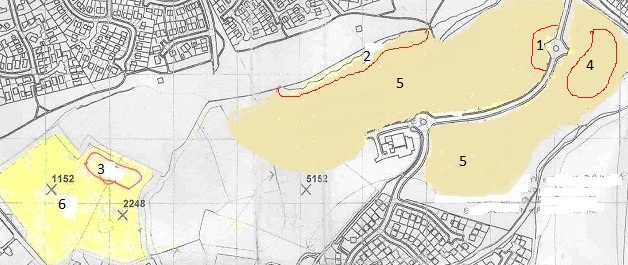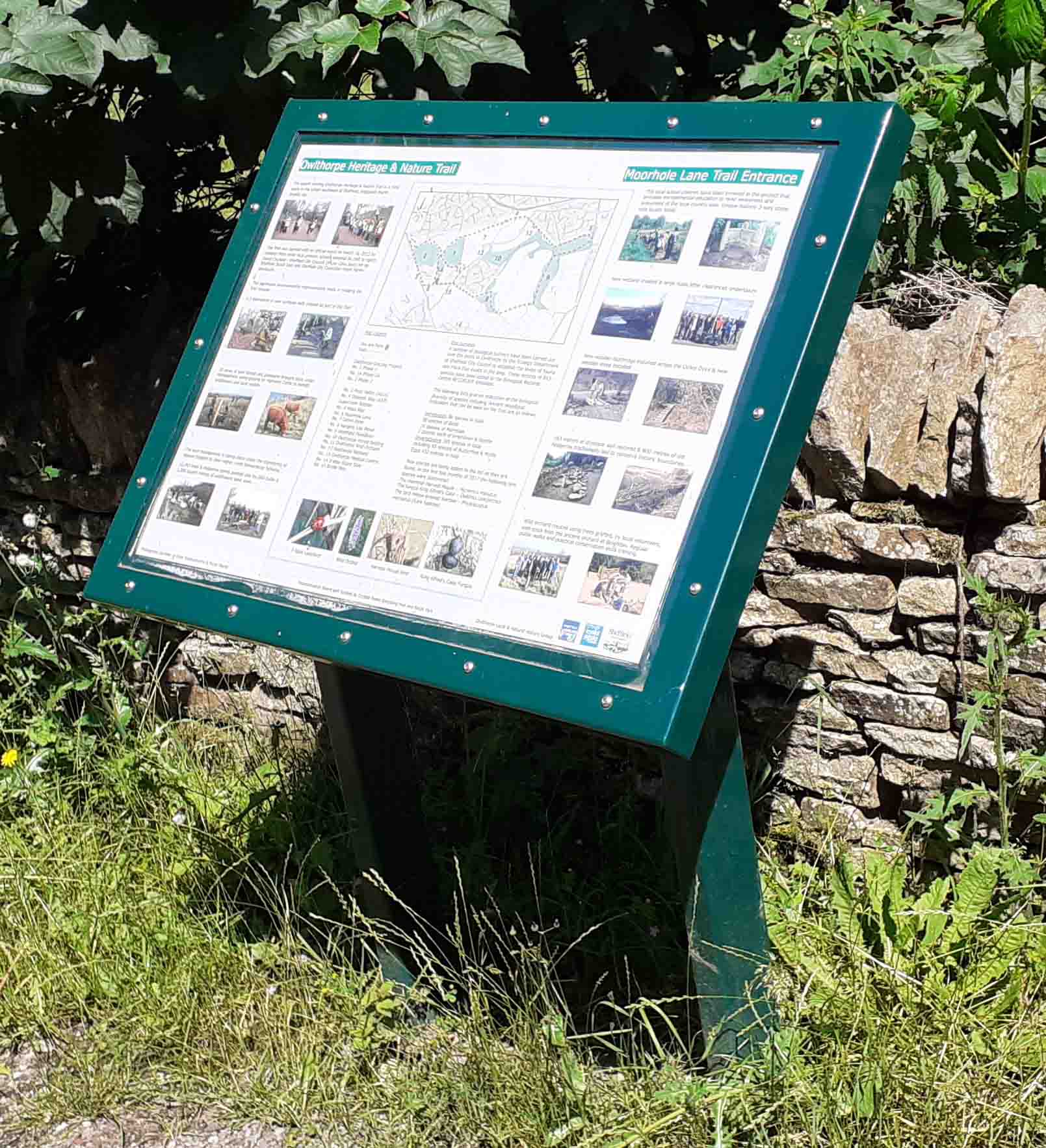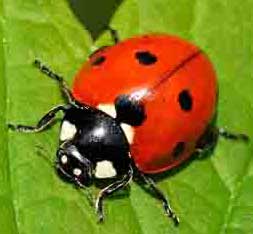Ecological Surveys |
|
Owlthorpe Meadows Invertebrate Survey - 2010Derek Whiteley Records added to Sheffield Biological Records Centre RECORDER database. Surveyed on 8 July 2010 , 11 August 2010 , and 9 September 2010 , and including records from Paul Richards on 13 October 2010 . Other species will occur in April, May and June, and these will have been missed by this year's survey. Additional specimens are still undergoing critical identification by experts and the moth list from the Sorby Moth Night should take the species list to above 170. Areas surveyed are shown below.
141 species have been identified so far. This list includes some species that are nationally localised and some species that are scarce in Sheffield . The “Potential Development (2010) Grasslands” Areas 1, 2, 4, 5 on the map Area 1 has a very interesting assemblage of insects. It is a curved sunny slope by the first roundabout, with ruderal or sparse vegetation and patches of bare earth. This microhabitat has an assemblage of rare and localised species for Sheffield . The snail-killing fly Dichetophora obliterata is actually new to Sheffield and more typical of the Derbyshire limestone dales. The Slender Groundhopper Tetrix subulata and the European Chinchbug Ischnodemus sabuleti have recently spread into Sheffield but are still quite localised. Another snail-killing fly Coremacera marginata is a nice find, and the darkling beetle Lagria hirta found by Ziggy Senkans is noteworthy for Sheffield . The hoverfly Paragus haemorrhous is a very localised species of bare ground and sparse vegetation. Area 2 is highlighted as being especially rich. There is a colony of Purple Hairstreak butterflies associated with oak trees. At least 7 were seen in late afternoon on 11 August 2010 . More are likely. Ringlets, Large Skippers and Speckled Wood butterflies also favour this area. The spectacular longhorn beetle Agapanthia villosoviridescens was found on Hogweed in this area (conservation of Hogweed in proposed buffer strip). it breeds in large hogweed stems. The spectacular hoverfly Didea fasciata is another rarity in Sheffield and Nationally Notable. The attractive soldier fly Oxycera rara was found here. It is a semi-aquatic species probably breeding in a nearby wet flush. It is very localised in Sheffield . Brown Hawker and Migrant Hawker dragonflies feed along this sheltered edge. Results from this survey support the proposal for a wide buffer strip, to be managed as open grassland with occasional tall herb and with a transition of vegetation to the woodland edge. Eg grassland – tall herb – bramble – woodland. Margins to be scalloped to create sunny enclaves. Area 4 has an assemblage of interesting species including Adonis Ladybird, 22-spot Ladybird, the Thick-legged Flower Beetle Oedemera lurida , abundant Hairy Shieldbugs and galls of Urophora cardui (see below) Area 5. The grassland area between the medical centre and Ochre Dyke has some interesting species. This is also a good place for Ringlets, Speckled Woods and Large Skippers. Grassland butterflies such as Meadow Brown and Gatekeeper are common in open grassy areas, and day flying Narrow-bordered Five-spot Burnet Moths are abundant in July It was good to note the large galls on thistles produced by the attractive Picture-wing Fly Urophora cardui . This species has been gradually spreading from south England and these records are actually the first for Sheffield . It seems to be well established across the whole site. Conservation of thistles is important for this species and other uncommon species such as the picture wing fly Tephritis cometa (also a recent colonist of Sheffield ) Species List for Area 1,2,4,5 combined Scientific Name Common Name National Status (Recorder 3.3) Discus rotundatus a discus snail Common Limax maximus Great Grey Slug Common Cepaea nemoralis Brown-lipped Snail Common Helix aspersa Large Garden Snail Common Nanogona polydesmoides a flat-backed millipede Common Lithobius forficatus Common Centipede Common Aeshna grandis Brown Hawker Common Aeshna mixta Migrant Hawker Local UK Sympetrum striolatum Common Darter Common Tetrix subulata Slender Ground Hopper Local RDB Chorthippus brunneus Common Field Grasshopper Common Forficula auricularia Common Earwig Common Palomena prasina Large Green Shieldbug Common Dolycoris baccarum Hairy Shieldbug Common Ischnodemus sabuleti European Chinchbug Common Anthocoris nemoralis a flower bug or bloodsucking Common Anthocoris nemorum Common Flower Bug Common Calocoris quadripunctatus a plantbug or grassbug Common Calocoris norvegicus a potato capsid Common Capsus ater Common Black Plantbug Common Leptopterna dolabrata a grassbug Common Aphrophora alni a froghopper Common Cicadella viridis Blue-green Leafhopper Common Cychrus caraboides Snail Hunter Local UK Pterostichus niger a ground beetle Common Hippodamia variegata Adonis Ladybird Notable/Nb Adalia bipunctata Two-spot Ladybird Common Coccinella septempunctata Seven-spot Ladybird Common Harmonia axyridis Harlequin Ladybird Naturalise Calvia quattuordecimguttata Cream-spot ladybird Common Psyllobora vigintiduopunctata 22-spot Ladybird Common Lagria hirta a darkling beetle Nr Oedemera lurida a thick-legged flower beetle Local UK Leptura maculata a longhorn beetle Common Agapanthia villosoviridescens a longhorn beetle Local UK Apion frumentarium a seed weevil Common Sitona lineatus Pea and Bean Weevil Common Zygaena filipendulae Six-spot Burnet Common Zygaena lonicerae Narrow-bordered Five-spot Burnet Common Thymelicus sylvestris Small Skipper Common Ochlodes venata Large Skipper Local UK Pieris brassicae Large White Common Quercusia quercus Purple Hairstreak Local UK Cynthia cardui Painted Lady Migrant Aglais urticae Small Tortoiseshell Common Inachis io Peacock Common Pararge aegeria Speckled Wood Common Pyronia tithonus Gatekeeper Common Maniola jurtina Meadow Brown Common Aphantopus hyperantus Ringlet Common Scotopteryx chenopodiata Shaded Broad-bar Common Tyria jacobaeae Cinnabar Common Sciara hemeroboides Sciarid Fly Common Beris geniculata a soldier fly Common Beris vallata a soldier fly Common Chorisops tibialis a soldier fly Common Oxycera rara a soldier fly Local UK Chloromyia formosa a soldier fly Common Microchrysa polita a soldier fly Common Rhagio tringarius a snipe fly Common Leptogaster cylindrica a robber fly Common Empis (Kritempis) livida a dance fly Common Paragus haemorrhous a hoverfly Local UK Didea fasciata a hoverfly Notable/Nb Epistrophe grossulariae a hoverfly Local UK Episyrphus balteatus a hoverfly Common Sphaerophoria scripta a hoverfly Common Syrphus ribesii a hoverfly Common Syrphus torvus a hoverfly Common Cheilosia illustrata a hoverfly Common Eristalis arbustorum a hoverfly Common Eristalis nemorum a hoverfly Common Eristalis pertinax a hoverfly Common Helophilus pendulus a hoverfly Common Volucella pellucens a hoverfly Common Syritta pipiens a hoverfly Common Conops flavipes a bee-killing fly Common Tephritis cometa a gall fly Local UK Tephritis formosa a gall fly Local UK Coremacera marginata a snail-killing fly Local UK Dichetophora obliterata a snail-killing fly Local UK Tetanocera elata Common Slug-killing Fly Common Tachina fera a tachinid fly Common Strongylogaster multifasciata Bracken Sawfly Common Pimpla hypochondriaca an ichneumon wasp Common Amblyteles armatorius an ichneumon wasp Common Myrmica scabrinodis a red ant Common Lasius niger Small Black Ant Common Vespula vulgaris Common Wasp Common Bombus lucorum White-tailed Bumble Bee Common Bombus lapidarius Large Red Tailed Bumble Bee Common Bombus pratorum Early Bumble Bee Common Bombus pascuorum Common Carder Bee Common Apis mellifera Honey Bee Common Trichoniscus pusillus Common Soil Woodlouse Common Trichoniscus pygmaeus Tiny White Woodlouse Common Oniscus asellus Common Shiny Woodlouse Common Philoscia muscorum Long-legged Woodlouse Common Porcellio scaber Common Rough Woodlouse Common Nelima gothica a harvestman Local UK Pisaura mirabilis Tent Spider Common Araneus diadematus Garden Orb-web Spider Common The Grazing Meadows, Areas 3 and 6 on the above map Surveyed on 12 August 2010 and 9 September 2010 . These are only snapshots of the site on two days in late summer and many springtime and midsummer species will have been missed. Area 3 is the most interesting part of the western fields. Vegetation is lower and more varied with patches of damp mud and wet ruts providing a suitable habitat for a good population of Slender Ground Hoppers – a local Red Data Book species. The snail killing fly Coremacera marginata lives here and is quite localised in Sheffield . Area 6 is quite rich in common insects. Good numbers of Seven-spot Ladybirds, Speckled Wood, Hairy Shieldbugs, bumblebees, soldier beetles, hoverflies, Green Shieldbugs, Blue Leaf Beetles ( Altica lythri ). The picture wing gall fly Tephritis formosa is noteworthy for Sheffield – and requires sowthistles ( Sonchus species). Urophora cardui also occurs here as galls on Thistles and is new to Sheffield . The site is getting overgrown by brambles, willowherbs and scrub, which will tend to limit the overall fauna to a few selected species. The area would benefit from some careful clearance and a grazing regime that allows plants to flower and seed in the summer. A greater range of plants in flower would be useful, and some open sunny areas of grassland with grass stems of varying height. Grazing regime needs to be carefully managed to prevent poaching and allow some growth. As always, thistles, knapweeds, and a variety of low growing yellow flowers will promote a greater diversity of insects. Need to retain some Ragwort for Cinnabar moths. Species List for Area 3 & 6 combined Scientific Name Common Name National Status Tetrix subulata Slender Ground Hopper Local RDB Forficula auricularia Common Earwig Common Palomena prasina Large Green Shieldbug Common Dolycoris baccarum Hairy Shieldbug Common Phytocoris tiliae a plantbug or grassbug Common Stenodema laevigatum a grassbug Common Notostira elongata a grassbug Common Aphrophora alni a froghopper Common Rhagonycha fulva Common red soldier beetle Common Coccinella septempunctata Seven-spot Ladybird Common Harmonia axyridis Harlequin Ladybird Naturalise Calvia quattuordecimguttata Cream-spot ladybird Common Altica lythri a leaf beetle Common Sitona lineatus Pea and Bean Weevil Common Pieris brassicae Large White Common Pieris rapae Small White Common Polyommatus icarus Common Blue Common Pararge aegeria Speckled Wood Common Pyronia tithonus Gatekeeper Common Maniola jurtina Meadow Brown Common Tyria jacobaeae Cinnabar Common Autographa gamma Silver Y Common Sciara hemeroboides Sciarid Fly Common Pachygaster leachii a soldier fly Local UK Melanostoma mellinum a hoverfly Common Platycheirus clypeatus sens. str. a hoverfly Common Platycheirus rosarum a hoverfly Local UK Eupeodes latifasciatus a hoverfly Local UK Eupeodes luniger a hoverfly Common Scaeva pyrastri a hoverfly Common Sphaerophoria scripta a hoverfly Common Eristalis intricaria a hoverfly Common Syritta pipiens a hoverfly Common Urophora cardui a gall fly Common Terellia ruficauda a gall fly Common Tephritis formosa a gall fly Local UK Tephritis neesii a gall fly Local UK Xyphosia miliaria a gall fly Common Coremacera marginata a snail-killing fly Local UK Hydromya dorsalis a snail-killing fly Common Tetanocera elata Common Slug-killing Fly Common Opomyza germinationis an opomyzid fly Common Tachina fera a tachinid fly Common Phasia obesa a tachinid fly Local UK Lasius niger Small Black Ant Common Lasioglossum calceatum Slender Mining Bee Common Bombus lucorum White-tailed Bumble Bee Common Bombus lapidarius Large Red Tailed Bumble Bee Common Bombus pascuorum Common Carder Bee Common Araneus diadematus Garden Orb-web Spider Common Derek Whiteley October 2010 |
|


